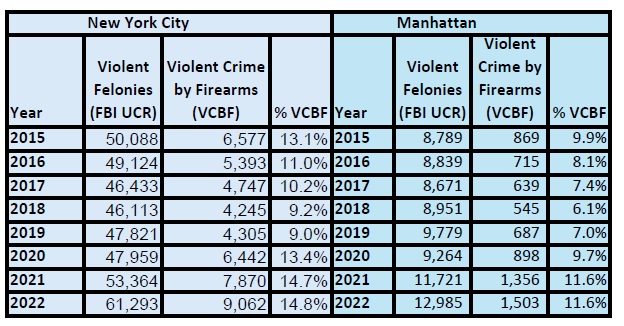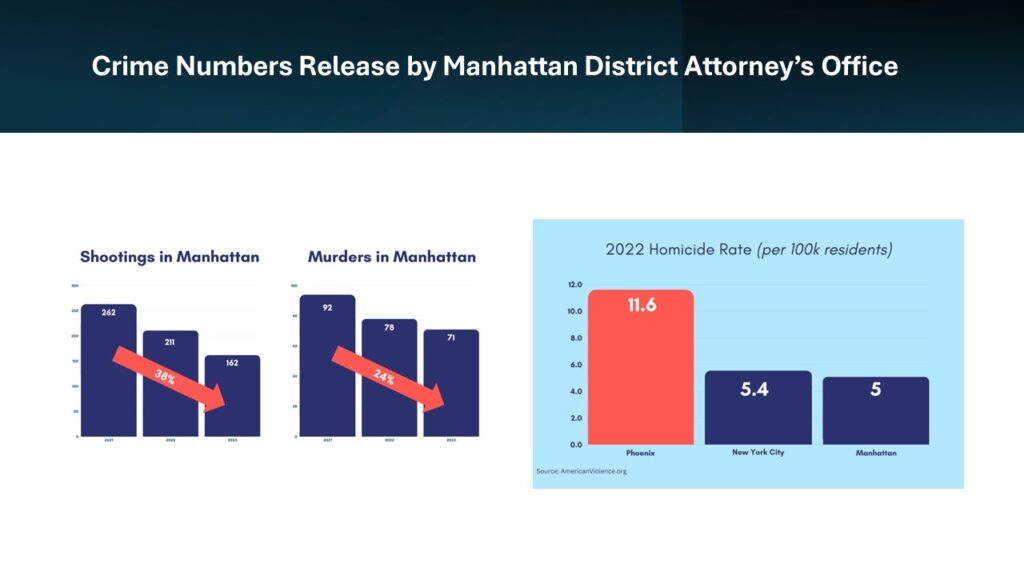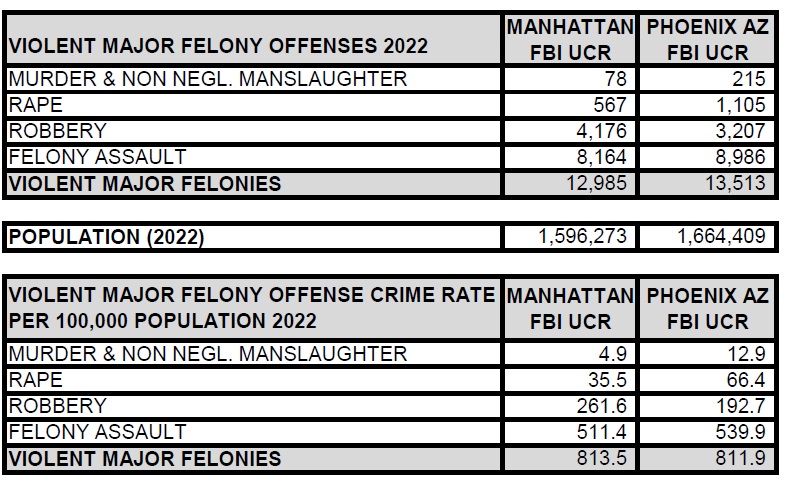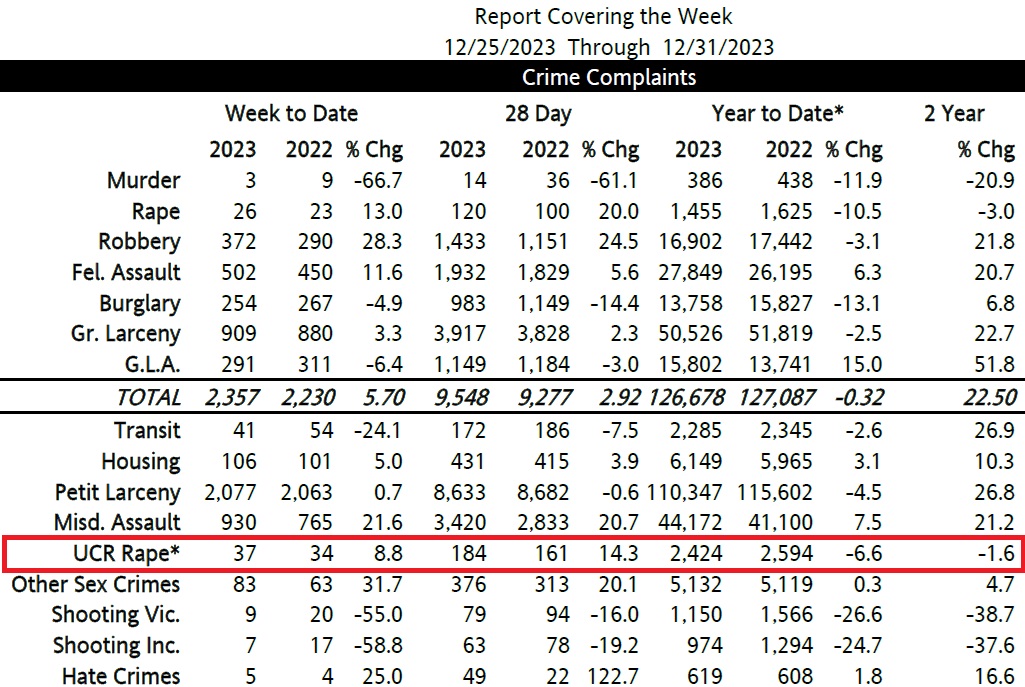Summary
- Underreporting Violent Crime in New York City: Deviations from the FBI’s Uniform Crime Reporting (UCR) definitions have led to a significant underreporting of violent crime statistics in New York City (NYC). This has caused a persistent underrepresentation of violent crimes, with major felonies being reported at much lower rates than they actually occur.
- Political Impact on Crime Statistics: New York City’s politicians, such as Mayor Eric Adams and Manhattan District Attorney Alvin Bragg, tend to cherry-pick crime data to portray their policies favorably, instead of providing a full and truthful depiction of the violent crime situation in NYC and Manhattan, respectively.
- Escalation of Violent Crime: New York City is experiencing an alarming increase in violent major felony crimes. The figures have escalated from 36,143 in 2019, the year preceding the COVID pandemic and the enactment of New York State’s contentious bail reform law, to 46,632 in 2023. This represents a significant rise of 29%.
- Shootings Classification: New York City applies a stringent standard for categorizing shootings, only recognizing incidents where an individual is hit by gunfire. Cases where bullets do not hit anyone are not classified as shootings by the city. This narrow definition is exploited by Mayor Eric Adams and Manhattan District Attorney Alvin Bragg to imply that gun-involved crime rates are lower than they are in reality.
- Surge in Gun-Related Violent Crimes: In 2019, the year preceding the COVID pandemic and the enactment of bail reform, the number of violent major felonies that involved firearms was 4,305 in New York City. By 2022, this figure had surged to 9,062, a 110.5% increase, representing the highest number recorded since at least 2015, based on accessible data. In Manhattan specifically, violent major felonies involving firearms increased from 687 in 2019 to 1,503 in 2022. This represents a significant rise of 119% and is the highest number since at least 2015, as indicated by the available data.
- Recommendations for Accurate Reporting: To ensure a more accurate portrayal of violent crime in New York City’s weekly reports, adopting FBI UCR standards for crime reporting is crucial. Additionally, it is important to include all gun-related offenses in the data.
Misleading Violent Crime Statistics
The statistics on violent crime released by the New York City Police Department (NYPD) are not reliable and are misleading. The city deviates from the definitions of rape and aggravated assaults as set by the FBI’s Uniform Crime Reporting (UCR), resulting in a clear underreporting of the city’s actual crime rate. Politicians and officials of NYC, including Mayor Eric Adams and Manhattan District Attorney Alvin Bragg, often cherry-pick certain figures related to crime to cast themselves and their policies in a positive light, instead of providing a full and truthful depiction of the violent crime situation in NYC. This article seeks to expose the ways in which NYC underreports violent crime and suggests a more accurate method for its quantification.
Index Crimes and Seven Major Felony Crimes
The FBI’s Uniform Crime Reporting (UCR) Program tracks seven major felony offenses: Murder, Rape, Robbery, Aggravated Assault, Grand Larceny, Burglary, and Motor Vehicle Theft. These crimes are collectively known as index crimes and serve as a benchmark for the FBI to measure crime rates across the country using uniform definitions applicable to all jurisdictions. Among these, Murder, Rape, Robbery, and Aggravated Assault are categorized as violent major felonies. While New York City employs a similar classification for violent major felonies, it adheres to the definitions set forth by the New York State Penal Law (NYSPL), which are more restrictive than the FBI’s UCR standards.
In New York City, Felony Assault is used instead of Aggravated Assault to comply with the NYSPL’s stricter definition. The city’s definition of Rape also adheres to the more limited scope defined by NYSPL.
Analysis of New York City’s crime statistics reveals a consistent pattern of underreporting Rape and Aggravated Assault annually. This discrepancy results in a reported violent crime rate that is consistently lower than what is indicated by FBI statistics. The primary issue arises from New York City’s adoption of definitions that deviate from those employed by the FBI’s UCR Program, leading to a significant underreporting of violent crimes. Consequently, the city has reported violent major felonies at rates substantially lower than actual occurrences: 24% in 2019, 26% in 2020, 28% in 2021, and 26% in 2022. As of now, the FBI has not disclosed crime statistics for 2023.
How Mayor Eric Adams Misled Constituents
Since 2019, the year before the COVID pandemic and the implementation of New York State’s contentious bail reform law, violent major felonies in New York City have surged from 36,143 to 46,632 in 2023—a startling rise of 29%. Mayor Eric Adams, who took office in 2022, has persistently downplayed the gravity of this worrying escalation.
Mayor Adams’ selective disclosures underscore a 12% drop in murders and a 25% reduction in shootings for 2023 yet fail to provide a comprehensive view of violent major crimes since bail reform began in 2020 and throughout his tenure as mayor. Since taking office, there has been a yearly increase in violent major felonies, climbing from 38,645 in 2021 to 45,529 in 2022, and peaking at 46,632 in 2023, which is a 21% increase since his mayoral term commenced. In 2023, the number of violent major felony offenses in NYC surpassed that of any year since 2003.
The Undercounting of Major Violent Felonies in Manhattan
Since New York City does not adhere to the FBI’s UCR definitions, it has significantly underreported the number of violent major felony offenses in Manhattan: by 24% in 2019, 24% in 2020, 26% in 2021, and 25% in 2022.
How Manhattan District Attorney Alvin Bragg Misled Constituents
Major violent felony offenses in Manhattan have escalated from 7,394 in 2019, the year preceding the COVID pandemic and bail reform, to 9,268 in 2023—an astonishing increase of 25%. Manhattan District Attorney Alvin Bragg, who took office in 2022 alongside Mayor Eric Adams, has consistently downplayed this disturbing trend. In contrast to Mayor Adams, District Attorney Alvin Bragg endorsed the bail reform.
During a recent dispute over the extradition of a murder suspect with Maricopa County Attorney Rachel Mitchell, Manhattan District Attorney Alvin Bragg selectively cited crime statistics to defend his tenure as a prosecutor and to undermine Mitchell’s credibility. Bragg asserted that since his inauguration as district attorney in 2022, shootings have plummeted by 38% and homicides by 24%. He highlighted the disparity between Manhattan’s homicide rate of 5 per 100,000 residents and Phoenix, Arizona’s higher rate of 11.6 per 100,000 residents. Refer to the images disseminated by Bragg’s office below:
Nonetheless, Bragg’s comparisons are deceptive and incomplete because they fail to consider additional factors and broader contexts when comparing crime rates between Manhattan and Phoenix, particularly violent felonies such as rape, robbery, and felony assaults. For instance, if an individual is severely beaten yet narrowly survives the assault, this should also be recognized as a crime by Manhattan District Attorney Alvin Bragg.
It is crucial to evaluate other elements and broader perspectives when contrasting crime rates between Manhattan and Phoenix. A selective focus on specific statistics does not provide a comprehensive view of the overall crime landscape in both cities.
The number of shooting incidents in Manhattan in 2023 (162) was still 35% higher than 2019 (120), the year before the COVID pandemic and bail reform. The number of major violent felony crimes was higher in each year that Alvin Bragg held office, with 9,705 incidents in 2022 and 9,268 in 2023, compared to the year before his tenure began, which recorded 7,045 incidents in 2021. Although there was a slight decrease in violent crimes in 2023 from the previous year’s figure, major violent crimes were still 38% higher in 2022 and 32% higher in 2023 than in 2021. Additionally, the count of major violent felony offenses in Manhattan reached its highest point since 2005, except for the year 2023.
When the total number of homicides, rapes, robberies, and aggravated assaults using FBI UCR crime definitions are considered, Manhattan’s violent felony crime rate in 2022 was 813.5 per 100,000 residents. It was slightly higher than Phoenix, Arizona at 811.9 per 100,000 residents.
Shootings
New York City employs a strict criterion for classifying shootings, acknowledging only those incidents where an individual is struck by a bullet. Instances where the shooter misses the target are not deemed shootings by the city.
Mayor Eric Adams and Manhattan District Attorney Alvin Bragg claim that there has been a reduction in shootings. Nonetheless, they exploit this narrow definition to suggest that gun crime statistics are lower than they actually are. The New York State Department of Criminal Justice Services tracks violent crimes by firearm (VCBF). The number of violent crimes involving firearms significantly surpasses that of shootings and has shown an upward trend each year from 2020 to 2022, the most recent year for which data is available.
In 2019, the year preceding the COVID pandemic and the enactment of bail reform, New York City logged 4,305 violent major felonies that involved firearms. By 2022, this figure had surged to 9,062, a 110.5% increase, representing the highest number recorded since at least 2015, based on accessible data. In Mayor Eric Adams’ first year, 2022, firearm-related violent crimes rose by 15.1%.
In Manhattan specifically, violent major felonies involving firearms increased from 687 in 2019 to 1,503 in 2022. This represents a significant rise of 119% and is the highest number since at least 2015, as indicated by the available data. During District Attorney Alvin Bragg’s initial year in office in 2022, there was an increase of 11% in felony cases involving firearms.

How to Measure Violent Crime in NYC More Accurately
New York City publishes weekly summaries on seven key felony offenses, including four violent crimes: murder, rape, robbery, and felony assault. However, the actual extent of violent felonies, especially rapes and felony assaults, are underreported due to reliance on definitions from New York State Penal Law rather than the FBI’s Uniform Crime Reporting Program’s criteria. To more accurately represent all serious violent felonies, New York City should adopt the FBI UCR standards for its weekly reports. Although NYC reports rapes based on the FBI UCR definition, those numbers are not included in the Seven Major Felony Offense Category.
Note: In its latest report covering major felony crimes from 2000 to 2023, the NYPD subtly adjusted the figures for 2023, revealing a minor uptick in major felony offenses. Originally, Mayor Eric Adams had announced a reduction in major felonies but failed to correct his earlier inaccurate statements.
NYC should also report the number of violent crimes involving firearms and other weapons such as knives every week. Currently, the New York State Division of Criminal Justice Services website reports the number of violent firearm incidents annually, with a six-month delay after each year ends. These numbers should be updated weekly on the NYPD website along with the regular crime statistics.
Written by,
Sam Antar
© Copyright by Sam Antar. All rights reserved.





